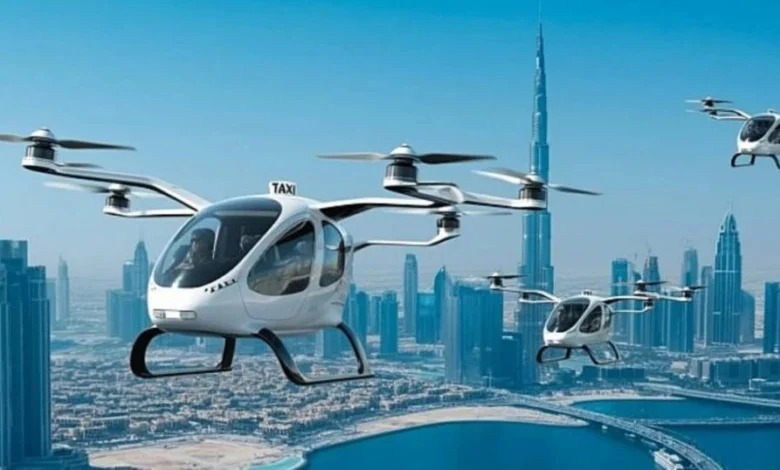
UAE Unveils First-Ever Flying Taxi Rules, Drone Corridors
UAE has developed a regulatory framework for flying taxis and delivery drones that marks a bold step toward transforming urban transportation nationwide. The aviation regulator plans to complete air taxi certification by the third quarter of 2026. Dubai will become the world’s first city to operate a commercial aerial taxi network by early that year.
The authorities have started mapping specialized air corridors to connect international airports and iconic landmarks throughout the Emirates. These strategic pathways will cut down travel time between major cities significantly. A trip between Dubai and Ras Al Khaimah could take just 15 minutes instead of the current one-hour drive. The proposed layered airspace model separates aircraft by altitude effectively – drone operations stay below 500 feet, a safety buffer exists from 500-1000 feet, air taxis operate between 1000-3000 feet, and conventional aircraft fly above 3000 feet. Three pilot sites in Abu Dhabi – Yas Island, Zayed Port, and Abu Dhabi International Airport – have been designated for testing to ensure safety and efficiency.
UAE launches simulation-based airspace rules for flying taxis
Image Source: Rude Baguette
“As aviation continues to evolve, our regulatory frameworks must evolve with it. Through this collaboration with TII and ASPIRE, we are laying the groundwork for safe and scalable integration of next-generation air mobility.” — Eng. Aqeel Al Zarooni, Assistant Director General for Aviation Safety Affairs, UAE General Civil Aviation Authority
TII and ASPIRE are spearheading a revolutionary project to make UAE a world leader in Advanced Air Mobility (AAM) regulations using sophisticated simulation models. These new rules go beyond traditional aviation frameworks. They tackle specific challenges of urban drone and air taxi operations, while the Smart and Autonomous Council leads national efforts in autonomous systems development.
UAE has moved beyond just talking about future air mobility – they’re already putting plans into action. The team is building unique simulation-based regulatory models for airspace corridors. These models factor in wind patterns around city buildings and set vital flight safety limits. This analytical approach means regulations stem from actual conditions, not just theories.
The regulatory work follows four key streams. Teams are designing safe air corridors, setting aircraft separation rules, linking traditional and unmanned traffic systems, and building expandable frameworks for each AAM maturity stage. Advanced simulation tools, created with the California Institute of Technology, support these efforts and strengthen UAE’s scientific authority in air mobility.
The simulation tests study 3D wind patterns around buildings and terrain. These patterns help define no-fly zones, safety buffers, and flight paths. The regulatory framework takes shape through extensive testing against UAE cities’ typical environmental conditions.
This project will run for two years. It allows for complete analysis before full implementation starts. This careful planning puts UAE in position to set global standards for safe, intelligent airspace systems that support both piloted and autonomous air taxis.
How UAE’s layered airspace model separates drones and air taxis
Image Source: ScienceDirect.com
UAE’s aerial transportation vision relies on an innovative layered airspace model. This model separates different aircraft types by altitude and serves as the foundation for regulating flying taxis and delivery drones.
The structure assigns specific flight zones based on how aircraft operate. Small delivery drones and recreational unmanned aircraft fly in the lowest tier below 500 feet. This keeps these lightweight vehicles safely away from other traffic. A vital safety buffer exists from 500 to 1000 feet. This empty protection layer keeps different aircraft categories apart.
Air taxis and larger unmanned aerial vehicles use corridors between 1000 and 3000 feet. These vehicles have plenty of space for urban transportation routes while staying separate from smaller drones below them. Traditional aircraft fly in their usual paths above 3000 feet. This ensures regular aviation continues smoothly alongside these new transportation methods.
This layered system reduces collision risks and makes airspace use more efficient. The model also has special transition zones. These zones let vehicles move safely between layers when needed, especially near vertiports and airports where different aircraft meet. This creates a complete three-dimensional traffic system that meets all the unique needs of next-generation aerial mobility.
Where UAE is testing vertiports and air taxi corridors
Image Source: IoT World Today
“Dubai is preparing to launch its first fleet of flying taxis by 2026, offering ultra-fast, electric air travel across the city.” — Joby Aviation, Global eVTOL Manufacturer and Operator
Abu Dhabi guides the implementation with three strategic test sites that are proving right innovative airspace configurations: Yas Island, Zayed Port, and Abu Dhabi International Airport. These locations showcase diverse environments—from tourist spots to maritime logistics centers—and serve as real-life testbeds for future vertiport operations.
The test flights have shown promising results. Archer Aviation completed its first vertical takeoff and landing flight at Al Bateen Executive Airport. EHang ran trials to review aircraft performance in Abu Dhabi’s challenging climate conditions that included heat, humidity, and dust exposure.
The emirate’s ambitious vertiport network ended up expanding to more than 10 state-of-the-art facilities. This network wants to connect urban centers and tourism hubs by linking Zayed International Airport, Al Bateen Executive Airport, Yas Island, Saadiyat, and Abu Dhabi Island.
Dubai has made equally most important progress by revealing Dubai International Vertiport (DXV). DXV sits near Dubai International Airport and stands as the first of four planned vertiports that will include Palm Jumeirah, Dubai Downtown, and Dubai Marina. GCAA granted technical design approval for DXV, and commercial air taxi operations will start in 2026.
Both emirates move faster toward full implementation, and Abu Dhabi also targets 2026 for commercial launch.
UAE leads aerial breakthroughs with its detailed regulatory framework for flying taxis and drone corridors. This pioneering system, without doubt the first worldwide, tackles the complex challenges of integrating unmanned aircraft in urban spaces. A layered airspace model separates different aircraft types by altitude. This creates a safer and optimized system for all aerial vehicles.
Initial tests at Abu Dhabi’s designated sites have shown promising outcomes. The project will grow to include more than ten vertiports throughout the emirate. These will connect major urban hubs and tourist spots. Dubai moves faster with its plans and has shown the Dubai International Vertiport as the first among four planned facilities.
UAE’s steadfast dedication to informed safety standards shines through the simulation-based approach. TII and ASPIRE worked together on this initiative. The authorities analyzed wind patterns and urban structures instead of relying on theoretical assumptions. This careful analysis helps create regulations that match UAE cities’ actual environmental conditions.
Abu Dhabi and Dubai aim to launch commercial operations by 2026. UAE’s residents and visitors will experience shorter travel times between major locations. To cite an instance, the trip between Dubai and Ras Al Khaimah will drop from over an hour to just 15 minutes.
UAE has established itself as a global standard for intelligent airspace management. The country moved from concepts to real-life implementation, becoming a pioneer in next-generation transportation. The certification process continues through 2026, bringing UAE closer to reshaping the scene of urban mobility with a unique, efficient aerial transportation network.





